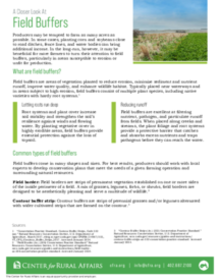Producers may be tempted to farm as many acres as possible. In some cases, planting corn and soybeans close to road ditches, fence lines, and water bodies can bring additional income. In the long-run, however, it may be beneficial for more farmers to turn their attention to field buffers, particularly in areas susceptible to erosion or unfit for production.
What are field buffers?
Field buffers are areas of vegetation planted to reduce erosion, minimize sediment and nutrient runoff, improve water quality, and enhance wildlife habitat. Typically placed near waterways and in areas subject to high erosion, field buffers consist of multiple plant species, including native varieties with hardy root systems.
Letting roots run deep
Root systems and plant cover increase soil stability and strengthen the soil's resilience against winds and flowing water. By planting vegetative cover in highly erodible areas, field buffers provide essential protection against the loss of topsoil.
Reducing runoff
Field buffers are excellent at filtering nutrient, pathogen, and particulate runoff from fields. When placed along creeks and streams, the plant foliage and root systems provide a protective barrier that catches and absorbs excess nutrients and traps pathogens before they can reach the water.


